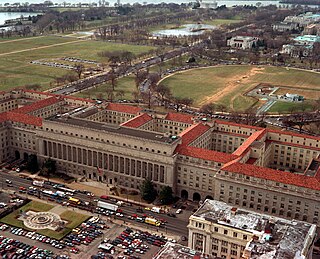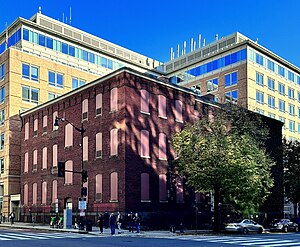
The National Building Museum is a museum of architecture, design, engineering, construction, and urban planning in Washington, D.C., United States. It was created by an Act of Congress in 1980, and is a private non-profit institution. Located at 401 F Street NW, it is adjacent to the National Law Enforcement Officers Memorial and the Judiciary Square Metro station. The museum hosts various temporary exhibits in galleries around the spacious Great Hall.

Northwest is the northwestern quadrant of Washington, D.C., the capital of the United States, and is located north of the National Mall and west of North Capitol Street. It is the largest of the four quadrants of the city, and it includes the central business district, the Federal Triangle, and the museums along the northern side of the National Mall, as well as many of the District's historic neighborhoods.

Logan Circle is a historic roundabout park and neighborhood of Washington, D.C., located in Northwest D.C. The majority of Logan Circle is primarily residential, except for the highly-commercialized 14th Street corridor that passes through the western part of the neighborhood. In the 21st century, Logan Circle has been the focus of urban redevelopment and become one of Washington's most expensive neighborhoods. Today, Logan Circle is also one of D.C.'s most prominent gay neighborhoods.

The West End is a neighborhood in the Northwest quadrant of Washington, D.C., bounded by K Street NW to the south, Rock Creek Park to the west and north, and New Hampshire Avenue NW and 23rd Street NW to the east. The West End is so named because it was the westernmost part of the original L'Enfant Plan for the city of Washington, before the annexation of Georgetown. It is home to the embassies of Spain and Qatar as well as the Delegation of the European Union to the United States. The George Washington University and George Washington University Hospital are on the edge of the West End, at Washington Circle.

The J. Edgar Hoover Building is a low-rise office building located at 935 Pennsylvania Avenue NW in Washington, D.C., in the United States. It is the headquarters of the Federal Bureau of Investigation (FBI).

The William Jefferson Clinton Federal Building is a complex of several historic buildings located in the Federal Triangle in Washington, D.C., across 12th Street, NW from the Old Post Office. The complex now houses the headquarters of the Environmental Protection Agency (EPA).

Petworth is a residential neighborhood in the Northwest quadrant of Washington, D.C. It is bounded to the east by the Armed Forces Retirement Home and Rock Creek Cemetery, to the west by Arkansas Avenue NW, to the south by Rock Creek Church Road NW and Spring Road NW, and to the north by Kennedy Street NW.
School Without Walls High School (SWW) is a small public magnet high school in the Foggy Bottom neighborhood of Washington, D.C. It is colloquially referred to by students and faculty as "Walls." The school is based on a concept in urban education that encourages students to "use the city as a classroom," which is the origin of its name.

The Herbert C. Hoover Building is the Washington, D.C. headquarters of the United States Department of Commerce.

The Sixteenth Street Historic District is a 1.25-mile (2.01 km) linear historic district in Washington, D.C., that includes all structures along 16th Street NW between H Street and Florida Avenue. The district's southern boundary is bordered by Lafayette Square, just north of the White House, and Meridian Hill Park on its northern boundary. It includes an eclectic mix of architectural styles on one of the city's most historic and important numbered streets including single and multi-family residential buildings, embassies, hotels, churches, and office buildings.

The Old Post Office, listed on the National Register of Historic Places as the Old Post Office and Clock Tower, is located at 1100 Pennsylvania Avenue, N.W. in Washington, D.C. It is a contributing property to the Pennsylvania Avenue National Historic Site.

The U.S. Custom house is a historic custom house in Portland in Multnomah County, Oregon. It was constructed to house offices of the United States Custom Service. It was built in 1898–1901 and is listed on the U.S. National Register of Historic Places. It is slated to become the second Portland location of Industrious, a coworking space provider, in Spring 2022.
Vlastimil Koubek was a Czech American architect who designed more than 100 buildings, most of them in the Washington, D.C., metropolitan area. When he died, he had designed buildings worth more than $2 billion. Most of his work is Modernist in style, although he developed a few structures in other vernaculars. He created the site plan for the redevelopment of Rosslyn, Virginia, and his Ames Center anchored the area's economic recovery. He also designed the World Building in Silver Spring, Maryland, which sparked redevelopment of that town's downtown and the L'Enfant Plaza Hotel in Washington, D.C., amongst many other buildings. In 1985, Washingtonian magazine considered him to be one of 20 people "who in the past 20 years had the greatest impact on the way we live and who forever altered the look of Washington." In 1988, The Washington Post newspaper said his Willard Hotel renovation was one of 28 projects in the area which made a signal contribution to the "feel" and look of Washington, D.C.

The outdoor statue of Benjamin Franklin in Washington, D.C., is located near the intersection of 12th Street and Pennsylvania Avenue, in front of the Old Post Office. The statue was a gift from Stilson Hutchins, founder of The Washington Post, who wanted to display his and the newspaper's stature in the city. The designer, Ernst Plassmann, and sculptor, Jacques Jouvenal, were both German-American artists. The architect of the memorial was J. F. Manning.

CityCenterDC, sometimes colloquially called CityCenter, is a mixed-use development consisting of two condominium buildings, two rental apartment buildings, two office buildings, a luxury hotel, and public park in downtown Washington, D.C. It encompasses 2,000,000 square feet (190,000 m2) and covers more than five city blocks. The $950 million development began construction on April 4, 2011, on the site of the former Washington Convention Center—a 10.2-acre (4.1 ha) site bounded by New York Avenue NW, 9th Street NW, H Street NW, and 11th Street NW. Most of the development was completed and open for business by summer 2015. The luxury hotel Conrad Washington, DC, opened in February 2019.

The James V. Forrestal Building is a low-rise Brutalist office building in Washington, D.C. Originally known as Federal Office Building 5, and nicknamed the Little Pentagon, the Forrestal Building was constructed between 1965 and 1969 to accommodate United States armed forces personnel. It is named after James Forrestal, the first United States Secretary of Defense. It became the headquarters of the United States Department of Energy after that agency's creation in 1977.

The Financial Historic District, previously known as the Fifteenth Street Financial Historic District, is a historic district in Washington, D.C. It encompasses 38 buildings, 2 of which are not contributing properties. Before 2016, the historic district included 20 buildings. The construction of the Treasury Building just east of the White House played a significant role in the financial district's development. Major banks and other financial institutions wanted to be close to the Treasury Building, therefore, many of the historic district's buildings were constructed along 15th Street NW, from Pennsylvania Avenue to I Street.

The Hamilton Hotel is a AAA 4-diamond hotel in downtown Washington, D.C., United States, located at 1001 14th Street, N.W., just to the north of Franklin Square. It is a member of Historic Hotels of America, the official program of the National Trust for Historic Preservation.

Mount Vernon Triangle is a neighborhood and community improvement district in the northwest quadrant of Washington, D.C. The neighborhood is located adjacent to Mount Vernon Square. Originally a working-class neighborhood established in the 19th century, present-day Mount Vernon Triangle experienced a decline in the mid-20th century as it transitioned from residential to commercial and industrial use. The neighborhood has undergone significant and rapid redevelopment in the 21st century. It now consists mostly of high-rise condominium, apartment and office buildings. Several historic buildings in the neighborhood have been preserved and are listed on the National Register of Historic Places. Mount Vernon Triangle is now considered a good example of urban planning and a walkable neighborhood.

The Demonet Building is composed of a historic townhouse and adjoining office building on the southeast corner of Connecticut Avenue and M Street N.W. in Washington, D.C. Constructed in 1880, the townhouse is the last Victorian residence on Connecticut Avenue between Dupont Circle and Farragut Square that has not been significantly altered. It features an octagonal tower topped by a dome with cartouche windows. Following a multi-year legal battle to demolish the townhouse, which had been added to the District of Columbia Inventory of Historic Sites in 1979, the Demonet Building and adjoining lot were sold for what was then a record price for downtown real estate. The adjoining office building, designed by Skidmore, Owings & Merrill, was completed in 1984.























